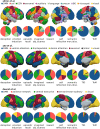Tasks activating the default mode network map multiple functional systems
- PMID: 35179638
- PMCID: PMC9098625
- DOI: 10.1007/s00429-022-02467-0
Tasks activating the default mode network map multiple functional systems
Abstract
Recent developments in network neuroscience suggest reconsidering what we thought we knew about the default mode network (DMN). Although this network has always been seen as unitary and associated with the resting state, a new deconstructive line of research is pointing out that the DMN could be divided into multiple subsystems supporting different functions. By now, it is well known that the DMN is not only deactivated by tasks, but also involved in affective, mnestic, and social paradigms, among others. Nonetheless, it is starting to become clear that the array of activities in which it is involved, might also be extended to more extrinsic functions. The present meta-analytic study is meant to push this boundary a bit further. The BrainMap database was searched for all experimental paradigms activating the DMN, and their activation likelihood estimation maps were then computed. An additional map of task-induced deactivations was also created. A multidimensional scaling indicated that such maps could be arranged along an anatomo-psychological gradient, which goes from midline core activations, associated with the most internal functions, to that of lateral cortices, involved in more external tasks. Further multivariate investigations suggested that such extrinsic mode is especially related to reward, semantic, and emotional functions. However, an important finding was that the various activation maps were often different from the canonical representation of the resting-state DMN, sometimes overlapping with it only in some peripheral nodes, and including external regions such as the insula. Altogether, our findings suggest that the intrinsic-extrinsic opposition may be better understood in the form of a continuous scale, rather than a dichotomy.
Keywords: Activation likelihood estimation; DMN; Insula; Semantics; Task-induced deactivations.
© 2022. The Author(s).
Conflict of interest statement
All the authors declare of having no conflict of interest.
Figures





Similar articles
-
Default mode network shows distinct emotional and contextual responses yet common effects of retrieval demands across tasks.Hum Brain Mapp. 2024 May;45(7):e26703. doi: 10.1002/hbm.26703. Hum Brain Mapp. 2024. PMID: 38716714 Free PMC article.
-
Distinctive and Complementary Roles of Default Mode Network Subsystems in Semantic Cognition.J Neurosci. 2024 May 15;44(20):e1907232024. doi: 10.1523/JNEUROSCI.1907-23.2024. J Neurosci. 2024. PMID: 38589231 Free PMC article.
-
Both Default and Multiple-Demand Regions Represent Semantic Goal Information.J Neurosci. 2021 Apr 21;41(16):3679-3691. doi: 10.1523/JNEUROSCI.1782-20.2021. Epub 2021 Mar 4. J Neurosci. 2021. PMID: 33664130 Free PMC article.
-
Cognition, emotion, and the default mode network.Brain Cogn. 2024 Dec;182:106229. doi: 10.1016/j.bandc.2024.106229. Epub 2024 Oct 30. Brain Cogn. 2024. PMID: 39481259 Review.
-
Rumination and the default mode network: Meta-analysis of brain imaging studies and implications for depression.Neuroimage. 2020 Feb 1;206:116287. doi: 10.1016/j.neuroimage.2019.116287. Epub 2019 Oct 23. Neuroimage. 2020. PMID: 31655111 Review.
Cited by
-
Towards a neurodevelopmental cognitive perspective of temporal processing.Commun Biol. 2024 Aug 14;7(1):987. doi: 10.1038/s42003-024-06641-4. Commun Biol. 2024. PMID: 39143328 Free PMC article. Review.
-
Rostral anterior cingulate connectivity in older adults with subthreshold depressive symptoms: A preliminary study.Aging Brain. 2022 Dec 15;3:100059. doi: 10.1016/j.nbas.2022.100059. eCollection 2023. Aging Brain. 2022. PMID: 36911261 Free PMC article.
-
Cognitive Normal Older Adults with APOE-2 Allele Show a Distinctive Functional Connectivity Pattern in Response to Cerebral Aβ Deposition.Int J Mol Sci. 2023 Jul 8;24(14):11250. doi: 10.3390/ijms241411250. Int J Mol Sci. 2023. PMID: 37511008 Free PMC article.
-
Default mode network shows distinct emotional and contextual responses yet common effects of retrieval demands across tasks.Hum Brain Mapp. 2024 May;45(7):e26703. doi: 10.1002/hbm.26703. Hum Brain Mapp. 2024. PMID: 38716714 Free PMC article.
-
Meta-analytic connectivity perturbation analysis (MACPA): a new method for enhanced precision in fMRI connectivity analysis.Brain Struct Funct. 2024 Dec 24;230(1):17. doi: 10.1007/s00429-024-02867-4. Brain Struct Funct. 2024. PMID: 39718568
References
-
- Brett M, Markiewicz CJ, Hanke M et al (2020) nipy/nibabel: 3.2.1. 10.5281/ZENODO.4295521
Publication types
MeSH terms
LinkOut - more resources
Full Text Sources

